|
|
|
|
|
Directory & Info for Fishing,
Angling, Fishing Tackle, Fishing Guides, Fly Fishing, Bass Fishing,
Sports fishing, Game Fishing....
See >>
Info on All types of
Fishing | Angling | Tackle etc
|
| |
|
Glossary of Fish, Seafood and Fishing Terms |
|
|
|
Australian Fish Bag Limits and Size Regulations |
|
Photos of Australian Seafood, Fish, Crustaceans &
Cephalopods and Information on each.... |
|
Abalone, Blacklip |
|
Albacore
Tuna |
|
Baler Shell |
|
Barbounia, Tiny |
|
Barracouta |
|
Barramundi |
|
Bass, Sea |
|
Batfish |
|
Batfish, Silver |
|
Blackfish |
|
Boarfish |
|
Bonito Tuna |
|
Bonito, Watson's Leaping |
|
Bream |
|
Bream, Butter |
|
Bream, Slate |
|
Bug, Moreton Bay
(Slipper Lobster) |
|
Bug, Balmain |
|
Butterfish |
|
Calamari,
Southern |
|
Carp, European |
|
Catfish, Blue |
|
Catfish, Lesser Salmon |
|
Cockles |
|
Cod, Bar |
|
Cod, Blue eye |
|
Cod, Coral Rock |
|
Cod, Ghost |
|
Cod, Maori |
|
Cod, Murray
|
|
Cod, Southern Rock |
|
Cod, Spotted |
|
Cod, Tomato |
|
Cod, Wirrah |
|
Cod, Yellow Spotted |
|
Coral Trout |
|
Cowanyoung |
|
Crab, Blue Swimmer |
|
Crab, Champagne |
|
Crab, Giant
|
|
Crab, Mud |
|
Crab, Spanner |
|
Crawfish |
|
Cuttlefish |
|
Dart Fish |
|
Dolphin Fish |
|
Dory, John |
|
Dory, Mirror |
|
Dory, Silver
|
|
Drummer, Southern |
|
Eel, Longfin |
|
Emperor, Red |
|
Emperor, Red Throat |
|
Flathead |
|
Flounder, Small Toothed |
|
Flutemouth, Rough |
|
Frost Fish |
|
Garfish |
|
Gemfish |
|
Goatfish |
|
Grouper |
|
Gurnard, Red |
|
Gurnard, Spotted |
|
Hairtail |
|
Hump Headed
Maori Wrasse |
|
Hussar |
|
Jackass Fish |
|
Jacket, Ocean |
|
Jacket, Sea |
|
Jewfish |
|
Jobfish, Gold Banned |
|
Jobfish, Rosy |
|
Kingfish,
Yellowtail |
|
Latchet Fish |
|
Leatherjacket, Reef |
|
Ling |
|
Lobster - Eastern
Rock |
|
Lobster - Southern Rock |
|
Long Tom |
|
Luderick |
|
Mackeral, Jack |
|
Mackerel, Slimey |
|
Mado |
|
Mahi Mahi |
|
Mangrove Jack |
|
Marlin, Black |
|
Marlin, Blue |
|
Marlin, Striped |
|
Melon Shell |
|
Monkfish |
|
Mono |
|
Moon Fish |
|
Morwong |
|
Morwong, Red |
|
Mullet - Roe |
|
Mullet, Diamond Scale |
|
Mullet, Red |
|
Mullet, Sea |
|
Mullet, Yelloweye |
|
Mulloway |
|
Mussels Black |
|
Mussels Greenlip |
|
Nanygai |
|
Octopus |
|
Orange Roughy |
|
Oreo, Black |
|
Oyster,
Native |
|
Oyster,
Pacific |
|
Oyster, Sydney Rock |
|
Parrot Fish |
|
Parrot Fish (2) |
|
Perch, Ocean |
|
Perch, Saddle Tail Sea |
|
Perch, Silver |
|
Perch, Splendid |
|
Perch, Stripey Sea |
|
Pig Fish |
|
Pike |
|
Pineapple Fish |
|
Prawn, Banana |
|
Prawn, King |
|
Prawn, Red Spot |
|
Prawn, School |
|
Prawn, Tiger |
|
Queenfish, Needleskin |
|
Rainbow Runner |
|
Redclaw Crayfish |
|
Redfish |
|
Ribaldo |
|
Ribbon Fish |
|
Rudder Fish |
|
Salmon, Atlantic |
|
Salmon, Australian |
|
Scad |
|
Scallops,
Queensland |
|
Scallops, Tasmanian |
|
Scorpion Fish, Raggy |
|
Shark |
|
Shark Black Tip |
|
Shark, Blue |
|
Shark Bronze Whaler (Dusky) |
|
Shark, Bull |
|
Sharks Fins |
|
Shark, Gummy |
|
Shark, Mako |
|
Shark, School |
|
Shark,
Tiger |
|
Shark,
Whiskery Reef |
|
Shark, White |
|
Shrimp, Mantis |
|
Sicklefish |
|
Silver Biddy |
|
Snapper |
|
Snapper, Big Eye |
|
Snapper, Fry Pan |
|
Snapper, Gold Band |
|
Snapper, King |
|
Snapper,
Red |
|
Snapper, Red Tropical |
|
Sole |
|
Sole, Tongue |
|
Squid, Arrow |
|
Squirrel Fish |
|
Stargazer |
|
Stingray, Butterfly |
|
Stripey Sea
Perch |
|
Surgeonfish, Sixplate Sawtail |
|
Sweetlip, Slatey |
|
Sweetlip, Yellow |
|
Swordfish |
|
Tailor |
|
Tarwhine |
|
Tilefish,
Pink |
|
Trevally, Big Eye |
|
Trevally, Golden |
|
Trevally, Silver |
|
Triple Tail |
|
Trout |
|
Trumpeter, Striped |
|
Tuna,
Albacore |
|
Tuna, Bigeye |
|
Tuna, Bluefin |
|
Tuna, Longtail |
|
Tuna, Skipjack |
|
Tuna, Striped |
|
Tuna, Mackerel |
|
Tuna, Yellowfin |
|
Venus Tusk Fish |
|
Whiting, Sand |
|
Whiting, School |
|
Wrasse |
|
Yabby,
Freshwater Crayfish |
|
Yellowtail |
|
FULL LIST of Fish &
Seafood |
|
Beche De Mer
(Sea Cucumber - Trepang) |
|
Amberfish |
|
Blackfish |
|
Black Teatfish |
|
Brown Sandfish |
|
Curryfish |
|
Elephants Trunks fish |
|
Greenfish |
|
Lollyfish |
|
Pinkfish |
|
Prickly Redfish |
|
Sandfish |
|
Stonefish |
|
Surf Redfish |
|
White Teatfish |
|
|
|
Commercial Seafood
Directory |
|
Sea-Ex Seafood, Fishing, Marine
Directory |
|
Aquaculture Directory |
|
Seafood
Trading Board |
|
Commercial Fishing |
|
Seafood Information by
Country |
|
Fish Photos & Fish
Information |
|
Interesting Fish Facts & Trivia |
|
Country Directories |
|
Thailand Business
Directory |
|
Seafood
|
|
Wholesale Seafood
Suppliers Australia |
|
Wholesale Seafood
Suppliers International |
|
Retail Seafood
Sales |
|
Seafood
Restaurants |
|
Seafood
Recipes |
|
Seafood
Information |
|
Seafood
Industry Resources |
|
Sea-Ex Seafood & Fishing
Directory -
Home Page |
|
Tasmanian
Scallops (Pecten fumatus) Photographs
and Information
|
Also known as Southern Scallop or
Commercial Scallop.
Tasmanian scallops have a thin shell, nearly circular and strengthened by radiating
ribs. In life the scallops rest on their paler, more convex lower valve which
slightly overlaps the darker, flat or slightly concave upper valve.
Tasmanian scallops are found in Australia's southern waters from mid New South Wales
down and around to mid Western Australia. They are found to depths of at least 120
metres over bare, soft sand or mud.
Scallops feed by filtering plankton and detritus from the water. They are preyed
upon by starfish and octopus.
Tasmanian scallops are taken commercially in NSW, Victoria and Tasmania. They are
caught using box-shaped mud dredges 2m to 3.5m wide. The dredges may be fitted with
teeth. As the dredge is dragged along the bottom, the teeth dig into the mud,
lifting the scallops so that they are caught in the dredge basket. Each dredge run
lasts up to 15 minutes, after which it is lifted and emptied. The boat then reverses
direction and fished back the other way.
Scallops belong
to the Pectinidae family. They have fan-shaped bivalve shells
with deep ridges that radiate from the hinge. Colours are
variable, including brown, orange, yellow, pink or
flesh-coloured or a mix of these. The upper valve of the shell
is flat, and the lower valve is concave.
|
 |
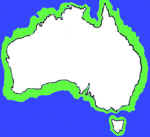 |
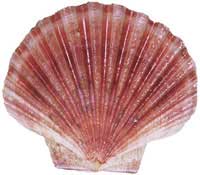
Saucer scallop roe is always cut off, whereas
the roe of commercial scallop is usually left on.
Dried scallops are popular in many parts of Asia.
Did You Know?
The scallop has a patron saint. Saint James wore the shell as
his personal emblem, which later became a badge for pilgrims who
visited his shrine in the Middle Ages. This is why a popular
scallop dish is called Coquille Saint-Jacques.
|
| Scientific Name |
Pecten fumatus |
| Location |
Australia wide |
| Season |
May to December |
| Size |
Varies |
| Australian Species Code |
00 651001 |
| Taste, Texture |
Scallop flesh is white and the
roe is usually bright orange. |
|
Nutritional
Information
For every 100 grams raw product
for Scallop meat. |
|
Kilojoules |
224 (53
calories) |
|
Protein |
11.6 g |
|
Cholesterol |
102 mg |
|
Sodium |
163 mg |
|
Total fat
(oil) |
0.9 g |
|
Saturated
fat |
32% of total
fat |
|
Monounsaturated fat |
15% of total
fat |
|
Polyunsaturated fat |
53% of total
fat |
|
Omega-3, EPA |
166 mg |
|
Omega-3, DHA |
116 mg |
|
Omega-6, AA |
21 mg |
|
|
Photos of
Tasmanian Scallops:
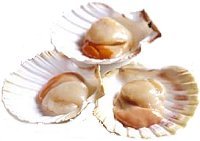 |
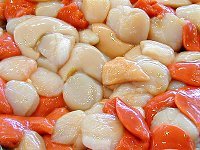 |
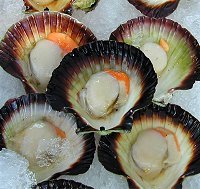 |
|
Scallops on
shell |
Scallop Meat Roe
On |
Scallops on
Shell, on ice |
|
|
|
|
|
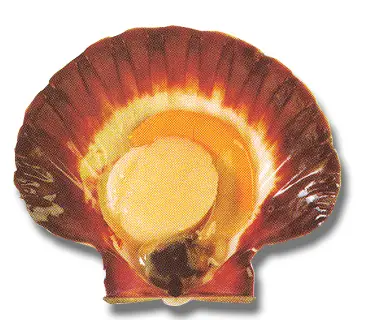 |
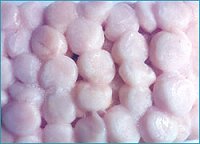 |
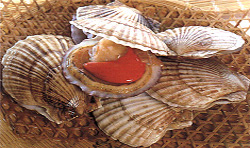 |
|
Scallop on half shell with roe |
scallop meat without roe |
scallops with roe inside scallop
shells |
|
|
Cooking
Tasmanian Scallops:
Scallops are strong and rich in
flavour with a medium -firm texture. They are popular
grilled or barbecued, but avoid overcooking, which causes
shrinkage, or the use of too much salt. Grill under a
salamander, then drizzle with lime juice and olive oil, or
sprinkle with fresh lemon zest and cracked pepper. Combine
with coriander, avocado and chilli salsa on a crispy
pappadum.
Scallops are tender with a sweet,
nutty flavour. The roe is pink with a firm texture when
cooked.
Create the perfect party dish by deep frying scallops in a
tempura batter and serve with a soy, ginger and garlic
dipping sauce, or present a potpourri of deep fried seafood
types such as prawns, oysters, mussels, finfish, calamari
and scallops with tartare, aioli, remoulade and fresh citrus
juices.
Poach scallops in a good court bouillon and use them as
studs in a salmon and white finfish terrine for contrasting
texture.
Scallop roe also provides excellent flavour for pates, soups
or chowders.
Scallops can be used in some
recipes as a replacement for
crab meat or
lobster.
SCALLOP RECIPES
Opening Scallops:
Place
scallop on board with flat shell up, insert the point of a
strong paring knife between the shells, and run it across the
underside of the top shell to sever the internal muscle. Pull
shells apart. Slide knife under Scallop to free it. Lift our
Scallop and pull off skirt and gut, leaving white Scallop flesh
with coral attached. Remove any dark membrane adhering to
Scallop flesh. Rinse well and drain. Wash and dry bottom shell
to use as a receptacle for cooking and serving Scallops.
How to Thaw Frozen
Scallops:
Don't thaw them in the microwave, they are to delicate and
you will start to cook them.
The best method for thawing is to place them the
refrigerator for 24 hrs, and then rinse lightly before
cooking them.
If time doesn't allow for an overnight thaw, place your
scallops in a zip-lock bag and run cold water over the bag
till they are thawed.
|
|
Commercial Fishing for
Tasmanian Scallops:
Scallops are harvested by dredging in deep offshore
waters. For maximum freshness, all processing is done at sea where they are cut,
washed, bagged and stored on ice or frozen at sea.
Sea scallops are commonly harvested with dredges or bottom
trawls on gravel, sand, or sand-mud bottoms.
Sea scallops are shucked and chilled on the boats after they are caught, this is
due to the fact that they cannot live out of water.
Another way of harvesting scallops is by diving for them. You will often times
see "diver scallops" advertised in stores or restaurants. Diver scallops are
harvested by hand in about 50 to 100 foot of water and often times in very poor
visibility.
Most of the diver scallops you will find will be the larger ones and will be
less gritty than dredge harvested scallops.

Wild and Farmed
Recovery Rate
Flesh with roe (commercial scallop): 20% of total weight (in half-shell), Flesh
without roe (saucer scallop): 15% of total weight (in half-shell).
The recovery rate varies depending on the species and roe
condition and retention.
The Tasmanian
scallop fishery is primarily based on the harvest of the
commercial scallop (Pectin fumatus). Although
commercial fishers can legally take the doughboy scallop (Mimachlamys
asperrimus) and the queen scallop (Equichlamys bifrons), they
have virtually no commercial significance in Tasmania.
The scallop fishery is highly regulated, with the Government
placing tight control on the management of the fishery. The main
management tools include a minimum size limit, closed areas and
catch restrictions based on a quota unit system.
This information is from
Dept. Primary Industries Parks, Water and Environment, Tasmania Grading can vary by supplier and region. Examples of
grading systems for scallops are presented below.
Terminology such as U-100 or U/100 is pronounced under one hundred and refers
to the number of scallops per a specified weight (pound or kilogram), in this
case fewer than 100 scallops per pound or kilogram. '10-20' is pronounced 'ten
twenty' and means that there are from 10 to 20 scallops per pound or kilogram.
Broken scallop meat
Sold without being graded by size
Exporters, Importers & Processors, Wholesale & Agents of
Scallops
See also:
Queensland Scallop
More links about
Tasmanian Scallops
Dept. Primary Industries Parks, Water and Environment, Tasmania - New
management plan for the Tasmanian Scallop Fishery, 2007, 2008, 2009 and 2010
Commercial Scallop Season, Scallop Catch updates.
Australian Government - Australian Bureau of Agricultural and Resource Economics
and Sciences (PDF file) - Australian Fisheries Statistics 2010/2011
Commonwealth Fisheries Association - The Commonwealth Fisheries Association
is committed to ensuring the commercial fishing industry is recognised for its
contribution to Australia’s economy, society and environment. CFA achieves this
by promoting and advocating the value of the industry and the healthy seafood it
provides to the community. Commonwealth wild harvest fisheries are among the
best managed and environmentally sustainable fisheries in the world. Our members
are committed to managing fisheries for Australia’s food security, community
well-being and healthy marine eco-systems.
|
|